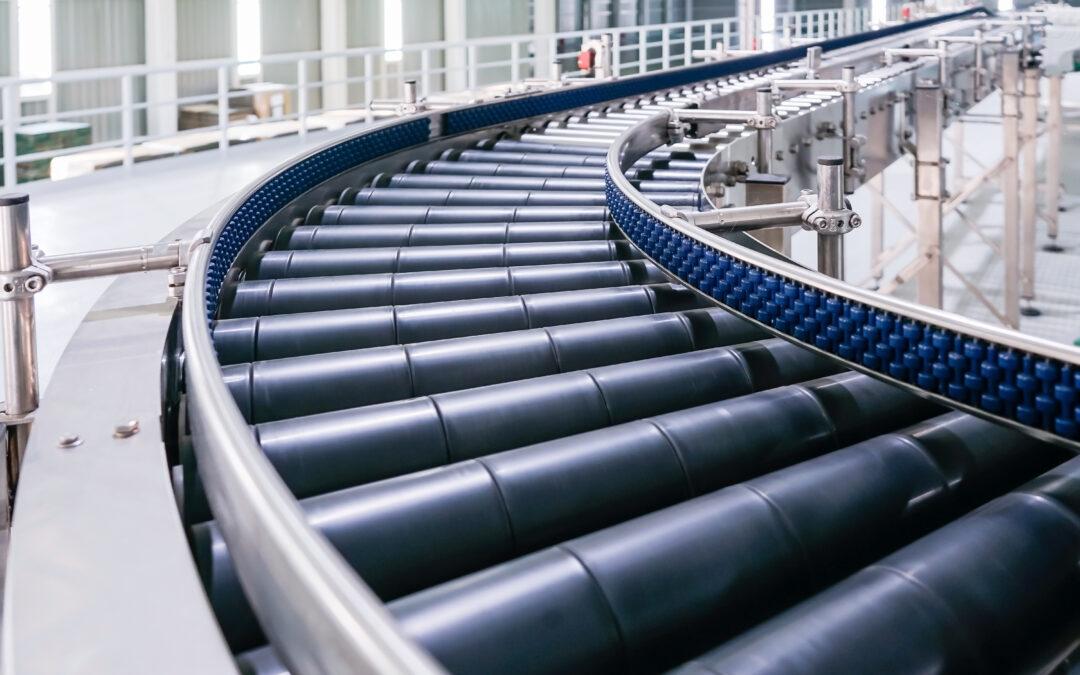Roller belts
Conveyor rollers are cylinder-shaped bars that run alongside and beneath a conveyor belt. Idler rollers come in a wide variety of designs and are used in a variety of ways. Conveyor systems usually have ball bearings to help support the weight of the materials being moved along the belt and to absorb the shock of any collisions that may happen. Further, they contribute to the material’s uninterrupted progression along the conveyor rollers.
Belt tracking can be maintained with the help of self-aligning idler rollers. Conveyor roller belts, also called “idler sets,” are often housed in metal frames of different sizes and shapes, chosen based on the belt’s structural and geometric needs.
Roller belt conveyors use rollers with ball bearings that are spaced out in a certain way to hold up both the moving side of the conveyor belt and the side that goes backwards. Roller conveyor belts are very important for the way a belt conveyor works. They must be made correctly, put in place securely, and cared for regularly. Idlers must have a few important features in order to be useful, such as giving the belt and the load they are carrying enough support and protection. Belt conveyor idlers for bulk materials are designed to incorporate rolls with various diameters. The rolls are mounted on shafts and equipped with anti-friction bearings and seals. The frictional resistance of the idler roll affects both the tension of the belt and the amount of power it needs. Idler roller conveyors are usually made of steel tubes that have been machined the same way all the way around the outer diameter and at both ends of the inner diameter. The tubes are mounted on antifriction bearings over a fixed steel spindle. The ends of the spindles are flattened to standard sizes so that they can fit quickly into slots in the structure of the idler. The material handling conveyors can also be made of heavy steel tubes for severe service conditions (like in the material loading section) or cast iron in corrosive applications (handling coke, etc.).
There are several types of idler roller conveyors. Let’s discuss some of them:
Customisable Idler Roller Options
Conveyor idler rollers can be custom made to provide a wide variety of functions. Brand, size, diameter, series, wall thickness, seal type, and material can all affect the performance of a given set of bearings. You can pick and choose which variables to modify to meet the needs of your program. Some of the things that determine which roller belt conveyors are used for a certain process are based on the type of material, its specific gravity, and the size of the lumps.
- Plain Idler Rollers
Plain rollers are the most common type of roller conveyor belts. They are used to support and shape the conveyor belt. All three types of frames (trough, tracking, and transition) can accommodate plain rollers on the load side of the belt. They can also be installed on the belt’s return side.
Tapered Idler Rollers
Tapered idler rollers can be installed on both the load and return sides of the belt. They assist with conveyor belt tracking when they are installed in a tracking frame.
- Rubber-Coated Idler Rollers
The rubber is glued right to the roller belt conveyor, which is why it is called a “rubber-coated idler roller.” Idler roller conveyors with a rubber coating last longer than those without a rubber coating because they are less likely to get torn, hit, or worn down by friction.
- Rubber Disc Idler Rollers
Rubber disk conveyor rollers are constructed with long-lasting rubber discs spaced evenly apart. The rubber discs are clustered at each end of the roller to provide the belt’s edge extra stability. The rubber disks are placed at regular intervals to keep carryback from happening. Carryback is when things stick to the belt after a scraper has cleaned it. This prevents belt mistracking caused by material accumulation on the outer roller.
Rubber Screw Idler Rollers
Rubber screw conveyor idlers have an anti-tear rubber coating in the shape of a series of screws that run along the entire length of the roller. The screw pattern helps remove material that has built up on the belt and keeps the belt moving in the right direction.
- Steel Screw Idler Rollers
Like their rubber counterparts, steel screw idler rollers are made with a coating that is shaped like a screw and goes all the way around the roller. On the other hand, it uses steel rather than rubber as a main component. The screw helps clean the belt and keep it on the right track by getting rid of debris. For situations with a lot of carryback, steel screw idler rollers are preferable because of their stronger scouring action compared to rubber screw rollers. A steel screw idler could be useful on a mobile plant conveyor, for instance, because scrapers can’t be used to clean the belt. Since there isn’t enough room at a mobile plant conveyor, a scraper can’t be installed there. Another situation where such gadgets might not be allowed is on a folding conveyor.
At DPH Engineering, we make our own idler roller conveyors to last for the duration of the machine’s operation. High-quality ERW tubing is used in their production. Idlers made by DPH Engineering are the best because they have high-quality double-sealed bearings and labyrinth seals in their bearing housings.
We use cutting-edge technology to make our idlers, which are then put through strict quality checks. This means that our clients will have a longer service life, less rolling resistance, and lower operating costs.

